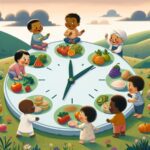Balancing macro and micronutrients in homemade toddler meals is crucial for the growth and development of your little one. It involves understanding the nutritional needs of toddlers and incorporating a variety of foods into their diet to meet these requirements. This guide will explore the importance of both macronutrients (carbohydrates, proteins, and fats) and micronutrients (vitamins and minerals) in toddler meals, offering parents and caregivers practical advice for preparing balanced and nutritious meals at home.
Understanding Toddler Nutritional Needs
Toddlers have unique nutritional needs that differ from those of older children and adults. Their bodies are growing rapidly, requiring a balanced intake of macronutrients for energy, growth, and development. Alongside, micronutrients play a pivotal role in supporting their immune system, bone health, and overall well-being. Balancing macro and micronutrients in homemade toddler meals is, therefore, essential to support their developmental milestones.
Carbohydrates are the primary energy source for active toddlers, while proteins are necessary for building and repairing tissues. Fats are essential for brain development and the absorption of certain vitamins. When it comes to micronutrients, vitamins such as A, C, and D, along with minerals like calcium and iron, are vital. However, ensuring a proper balance without over or under-doing any particular nutrient requires attention to detail and a bit of planning.
Balancing Macro and Micronutrients in Homemade Toddler Meals
Creating a balanced meal for toddlers doesn’t have to be complicated. The key is to include a variety of foods from all the food groups. For carbohydrates, opt for whole grains like brown rice, oats, and whole wheat bread. Proteins can come from lean meats, beans, and dairy products. Healthy fats can be included through avocados, nuts (if no allergies), and olive oil. When it comes to micronutrients, incorporating a colorful array of fruits and vegetables can ensure a wide range of vitamins and minerals are covered in their diet.
It’s also beneficial to be mindful of the portion sizes and the balance of nutrients within each meal. A good rule of thumb is to fill half the plate with fruits and vegetables, a quarter with protein, and the remaining quarter with whole grains. This simple visual guide can help in preparing meals that are nutritious and appealing to toddlers. Remember, the goal is to introduce them to a wide range of flavors and textures, encouraging a healthy relationship with food from a young age.
Practical Tips for Meal Preparation
Preparing balanced and nutritious meals requires some planning, but it doesn’t have to be overwhelming. Start by creating a weekly meal plan that includes a variety of foods. This not only helps in shopping and preparation but also ensures a diverse intake of nutrients. Shopping for seasonal fruits and vegetables can provide both freshness and cost-effectiveness. Furthermore, involving toddlers in meal preparation can make them more interested in trying new foods.
Batch cooking and freezing meals can be a time-saver for busy parents. Preparing larger quantities of recipes and storing them in portions can make meal times more manageable. Additionally, be creative in incorporating nutrients into meals. For example, adding spinach to smoothies or making homemade pizza with a whole wheat base and lots of vegetables. For more ideas on nutritious and delicious smoothie recipes for toddlers, check out smoothie recipes for toddlers.
Remember, every toddler is different, and so are their dietary preferences and needs. Monitoring your child’s response to various foods and adjusting meals accordingly is important. For toddlers with specific dietary needs, consulting a pediatric nutritionist can provide tailored advice to ensure their nutritional requirements are met. For more information on balancing solid food and milk intake for 9-month-olds, visit balancing solid food and milk intake for 9-month-olds.
In conclusion, balancing macro and micronutrients in homemade toddler meals is essential for their growth and development. By understanding their nutritional needs, incorporating a variety of foods, and planning meals thoughtfully, parents can ensure their toddlers receive the nutrients they need in a balanced and delicious way. For more tips on creating balanced vegetarian diets for one-year-olds, explore creating a balanced vegetarian diet for a one-year-old.













